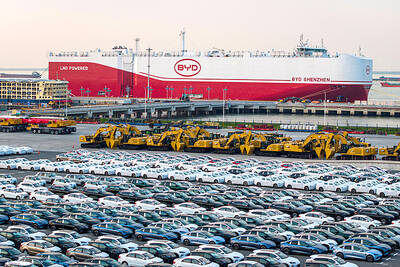Less crowded trading floors, facial recognition systems and split work areas could all become routine for bankers in Singapore as the city-state readies for office life in a post-COVID-19 world.
Financial institutions in the city-state should use more no-touch technology, allow more space for each employee and adopt split teams on trading floors once staff return after the COVID-19 pandemic, recommendations from a study commissioned by the city-state’s Monetary Authority of Singapore (MAS) and released yesterday said.
Lenders are being encouraged to use hot-desking, motion detectors, temperature and face-mask detection screening, and improved ventilation to avoid potential contamination, the report said.

Photo: EPA-EFE
Staff should be allowed to work from satellite offices or branches in addition to companies’ main headquarters, it said.
Such measures “are imperative to strike a balance between workplace safety and minimizing disruption to business operations,” said the study, which was carried out by real estate consultancy Cushman & Wakefield PLC and some of Singapore’s biggest banks.
With more than 200 financial institutions operating in Singapore, the city-state is looking at how to get staff back to the office after they have spent more than one year juggling working from home and family life.
The city-state has taken a cautious approach to returning staff to offices even as infection rates remain low.
The recommendations from Singapore envision a workplace that is geared to switch quickly to a “pandemic-on” mode so that companies can react to pandemics.
“MAS encourages our financial institutions to consider the recommended strategies in the Playbook to enhance safety and resiliency in the workplace,” MAS Deputy Managing Director Ong Chong Tee (王宗智) said in a statement. “This will be helpful to be well prepared for any situations in future that may require safe distancing and work-from-home arrangements.”
The report also compares Singapore’s approach in managing the pandemic with other major financial hubs, such as Hong Kong, Shanghai, London, New York and Sydney.
It found that the density of its offices is comparable to Sydney, with an average 7.4m2 to 11m2 per seat. That is more spacious than in Hong Kong, where it is 3.7m2 to 9m2.
How financial institutions adapt to a post-COVID-19 world has the potential to reshape business districts in hubs around the world.

Micron Memory Taiwan Co (台灣美光), a subsidiary of US memorychip maker Micron Technology Inc, has been granted a NT$4.7 billion (US$149.5 million) subsidy under the Ministry of Economic Affairs A+ Corporate Innovation and R&D Enhancement program, the ministry said yesterday. The US memorychip maker’s program aims to back the development of high-performance and high-bandwidth memory chips with a total budget of NT$11.75 billion, the ministry said. Aside from the government funding, Micron is to inject the remaining investment of NT$7.06 billion as the company applied to participate the government’s Global Innovation Partnership Program to deepen technology cooperation, a ministry official told the

Taiwan Semiconductor Manufacturing Co (TSMC, 台積電), the world’s leading advanced chipmaker, officially began volume production of its 2-nanometer chips in the fourth quarter of this year, according to a recent update on the company’s Web site. The low-key announcement confirms that TSMC, the go-to chipmaker for artificial intelligence (AI) hardware providers Nvidia Corp and iPhone maker Apple Inc, met its original roadmap for the next-generation technology. Production is currently centered at Fab 22 in Kaohsiung, utilizing the company’s first-generation nanosheet transistor technology. The new architecture achieves “full-node strides in performance and power consumption,” TSMC said. The company described the 2nm process as

Shares in Taiwan closed at a new high yesterday, the first trading day of the new year, as contract chipmaker Taiwan Semiconductor Manufacturing Co (TSMC, 台積電) continued to break records amid an artificial intelligence (AI) boom, dealers said. The TAIEX closed up 386.21 points, or 1.33 percent, at 29,349.81, with turnover totaling NT$648.844 billion (US$20.65 billion). “Judging from a stronger Taiwan dollar against the US dollar, I think foreign institutional investors returned from the holidays and brought funds into the local market,” Concord Securities Co (康和證券) analyst Kerry Huang (黃志祺) said. “Foreign investors just rebuilt their positions with TSMC as their top target,

POTENTIAL demand: Tesla’s chance of reclaiming its leadership in EVs seems uncertain, but breakthrough in full self-driving could help boost sales, an analyst said Chinese auto giant BYD Co (比亞迪) is poised to surpass Tesla Inc as the world’s biggest electric vehicle (EV) company in annual sales. The two groups are expected to soon publish their final figures for this year, and based on sales data so far this year, there is almost no chance the US company led by CEO Elon Musk would retain its leadership position. As of the end of last month, BYD, which also produces hybrid vehicles, had sold 2.07 million EVs. Tesla, for its part, had sold 1.22 million by the end of September. Tesla’s September figures included a one-time boost in